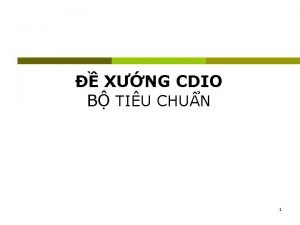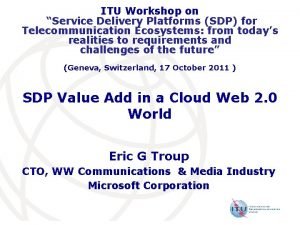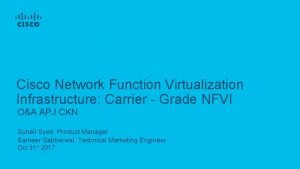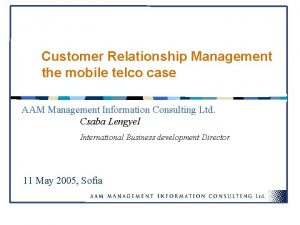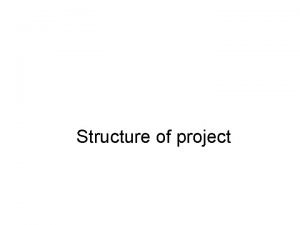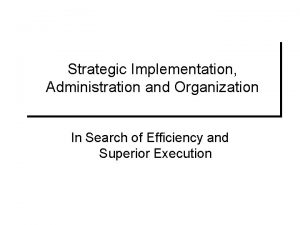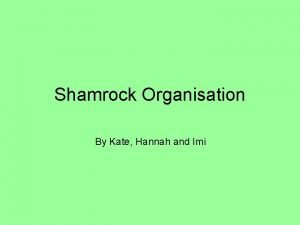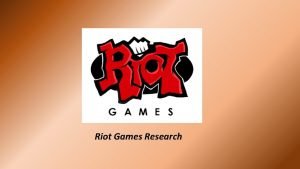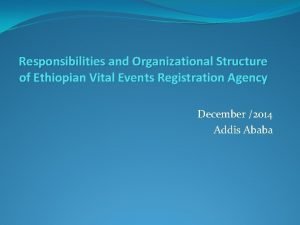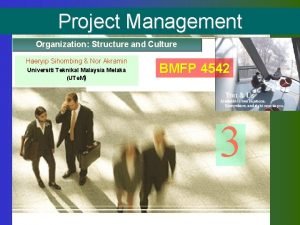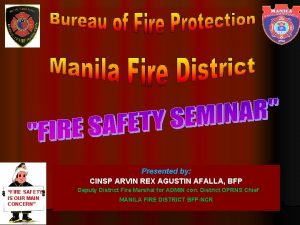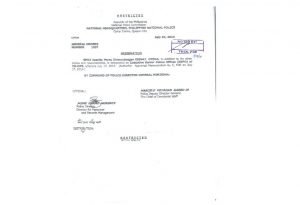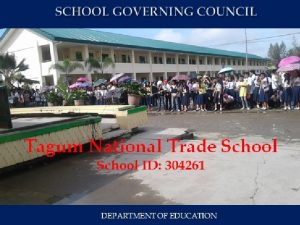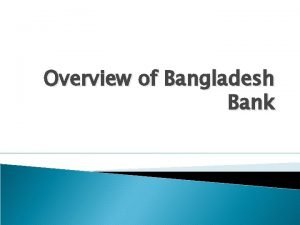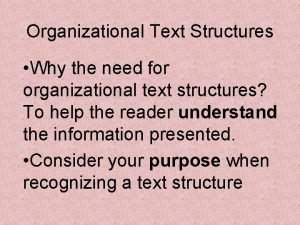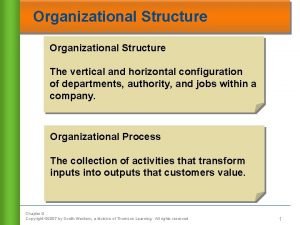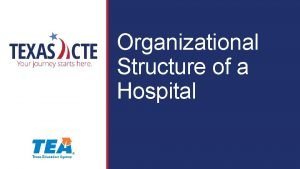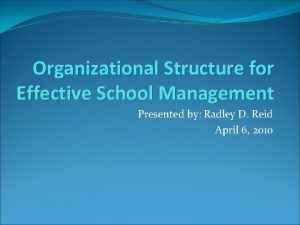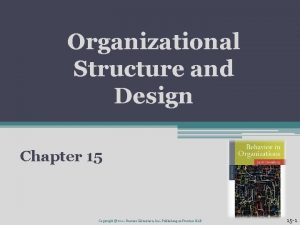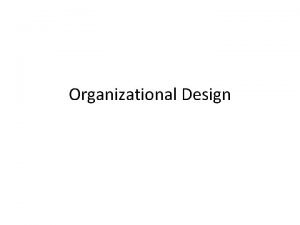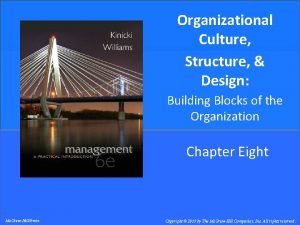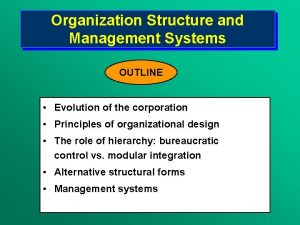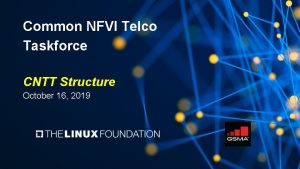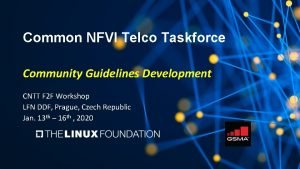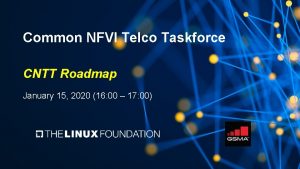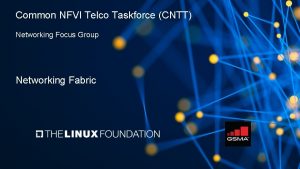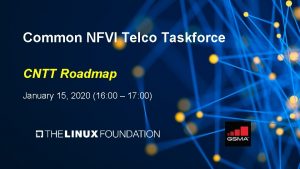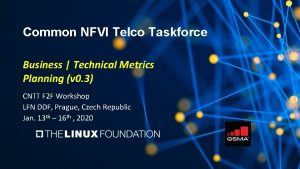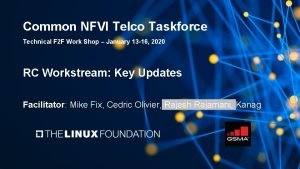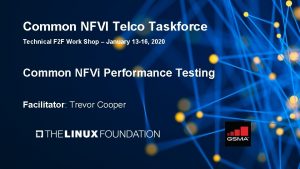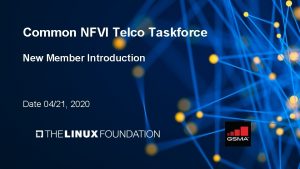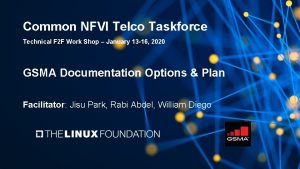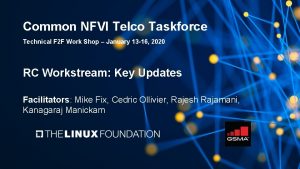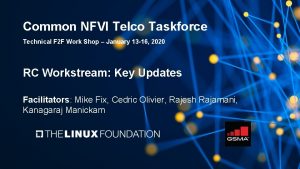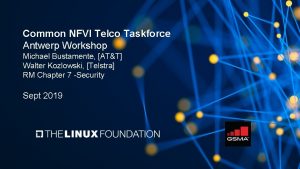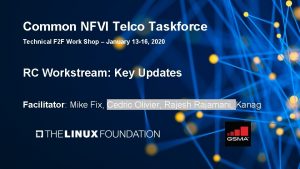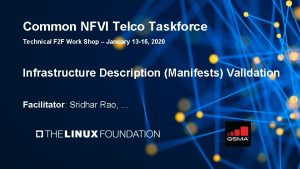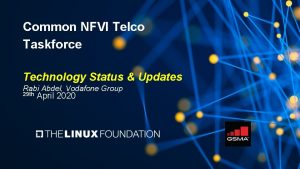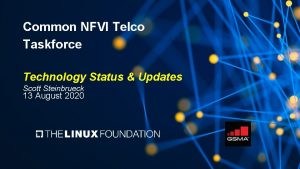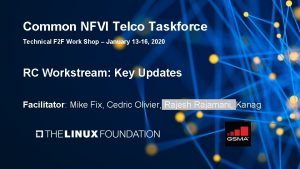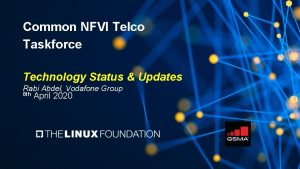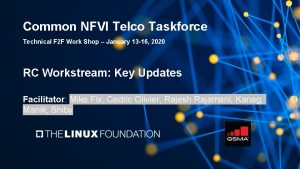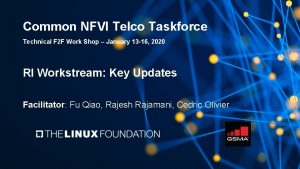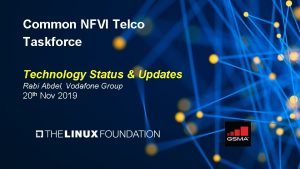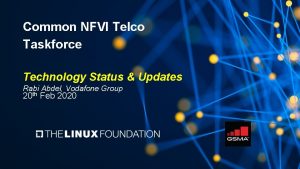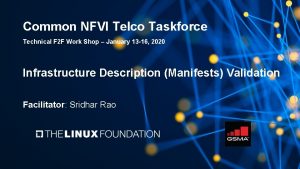Common NFVI Telco Taskforce CNTT Structure CNTT Organizational






























- Slides: 30

Common NFVI Telco Taskforce CNTT Structure

CNTT | Organizational Structure CNTT External Governance Communities Technical Steering RM Core RA 1 Core RA 2 Core RI 1 Core RC NFVI RM Ops RA 1 Ops RA 2 Ops RI 1 Labs RC VNF RM Compliance RA 1 Dev RA 2 Dev RI 1 Dev RC Dev

CNTT | Governance Workstreams and Structure CNTT External Governance Communities Leads: TBA Governance Steering Community Strategies & Oversight Lifecycle Management Recruiting, Engagement, & Adoption Marketing & Communications Business | Technical Metrics Technical F 2 F Work Shops

CNTT | Governance Workstreams Leads/Co-Leads WSL Responsibilities: • • • Define strategies, process, roadmap, & measures to achieve work stream objectives and success Drive content creation for each corresponding workstream Deliver on the strategy & plan Assign issues Track status and issues Seek community consensus Administer approval process. Drive workstream meetings and agenda Discuss unresolved issues Raise any concern to Governance meetings Community Strategies & Oversight Lifecycle Management Recruiting, Engagement, & Adoption Marketing & Communications Business | Technical Metrics Technical F 2 F Work Shops Note: If you would like to be considered for a lead/co-lead role, please send an email to Jonathan Beltran (jb 788 y@att. com) and Rabi Abdel (abdel. rabi@Vodafone. com). Note: If you would like to participate in any of these WS, please add your details into https: //wiki. lfnetworking. org/display/LN/CNTT+Workstreams Lead, Co-Lead TBA, TBA TBA, TBA

CNTT | Governance Workstream Scope Community Strategies & Oversight Lifecycle Management Recruiting, Engagement, & Adoption WSL: TBA, TBA Scope: • Define community strategies that align with Common NFVI mission, objectives & outcomes • Review & assess community success measures for required action(s) • Ensure compliance within the community to policies, process, & principles • Define process & tools required to create and manage GSMA / OPNFV feedback loop to RM, RA, RI, & RC • Collect feedback on lifecycle activities | processes | ecosystem to plan, track, & measure improvement initiatives • Drive culture of continuous improvement across Common NFVI Lifecycle Framework Work Stream List: • Recruit operators & suppliers to bring diverse perspective and contributions into the community • Drive membership engagement activities to address community resource demands • Engage industry leaders with Common NFVI value proposition to drive adoption rate • Drive adoption roadmap with VNF Vendors Add your name to Work Stream List: Add your name to Work Stream List Lead, Co-Lead

CNTT | Governance Workstream Scope Marketing & Communications Business | Technical Metrics Technical F 2 F Work Shops WSL: TBA, TBA Scope: • Identify and pursue opportunities to market community services through publication of white papers, press releases, business cases, & media events • Track community external speaking engagements • Create | maintain community messaging to ensure alignment in external communications • Define, create, & publish business value metrics based on ROI, Time to Market, etc. • Define, create, & publish success metrics for community processes and deliverables • Define, create, & publish contribution rates within the community • Define, create & publish adoption rates within the Industry • Conduct work shops ~4 X yearly • Create agendas that focus on issue resolution & community alignment • Ensure work shop logistical requirements are planned & managed • Ensure work shop artifacts are collected, organized, & stored • Seek opportunities to engage partner communities in work shops Work Stream List: Add your name to Work Stream List Lead, Co-Lead

CNTT | Technical Workstreams and Structure Technical Steering RM Core RA 1 Core RA 2 Core RI 1 Core RC NFVI RM Ops RA 1 Ops RA 2 Ops RI 1 Labs RC VNF RM Compliance RA 1 Dev RA 2 Dev RI 1 Dev RC Dev

CNTT | Technical Steering TSL: TBA, TBA Responsibilities: • • • Define Vision and Direction Define Workstreams Scope. Set Roadmap and Priorities. Track status and issues. • • Bring in alignment between workstreams. Seek community consensus and host voting when needed. Drive Technical Steering Meetings and agenda. Create New workstreams when needed. RM Core RA 1 Core RA 2 Core RI 1 Core RC NFVI RM Ops RA 1 Ops RA 2 Ops RI 1 Labs RC VNF RM Compliance RA 1 Dev RA 2 Dev RI 1 Dev Lead, Co-Lead

CNTT | Deciding on Technical Roadmap CNTT Governanc e F 2 F Workshops Input Git. Hub Issues Backlog Input Technical Steering Roadmap Items RM Core RA 1 Core RA 2 Core RI 1 Core RC NFVI RM Ops RA 1 Ops RA 2 Ops RI 1 Labs RC VNF RM Compliance RA 1 Dev RA 2 Dev RI 1 Dev RC Dev

CNTT | Technical Workstreams Leads/Co-Leads WSL RM Core RM Ops RM Compliance Responsibilities: • • • Drive content creation for their corresponding chapters. Deliver on the Roadmap. Assign PRs and issues to Committers. Track status and issues. Seek community consensus. Administer approval process and merge approved PRs. Drive technical meetings and agenda. Discuss PRs that has not got to a conclusion online. Raise any concern to Technical Steering meetings. Note: If you would like to be considered for a lead/co-lead role, please send an email to Jonathan Beltran (jb 788 y@att. com) and Rabi Abdel (abdel. rabi@Vodafone. com). Note: If you would like to participate as a committer into any of those WS, please add your details into https: //wiki. lfnetworking. org/display/LN/CNTT+Workstreams RA 1 Core RA 1 Ops RA 1 Dev RA 2 Core RA 2 Ops RA 2 Dev RI 1 Core RI 1 Labs RI 1 Dev RC NFVI RC VNF RC Dev TBA, TBA TBA, TBA TBA, TBA TBA, TBA Lead, Co-Lead

CNTT | RM Technical Workstreams Scope RM Core RM Ops RM Compliance WSL: TBA, TBA Scope: Ch 01: Introduction Ch 02: Requirements Analysis Ch 03: Modelling Ch 04: Infrastructure Abstraction Ch 05: NFVI Feature set Appendix-A: VNF Guidelines Scope: Ch 06: Interfaces & APIs Ch 07: Security Ch 09: Operations and LCM Scope: • Certification needs/LCM for both VNF and NFVI. • Self Certification and badges requirements. (types, hierarchy, etc) Add your name to Committers List Ch 08: Compliance and Verification Add your name to Committers List Lead, Co-Lead

CNTT | RA 1 Technical Workstreams Scope RA 1 Core RA 1 Ops RA 1 Dev WSL: TBA, TBA Scope: Ch 01: Introduction Ch 02: Requirements Ch 03: High Level Architecture Ch 04: Component Level Architecture Scope: Ch 05: Interfaces & APIs Ch 06: Security Ch 07: Operations and LCM Scope: Gaps analysis of existing technologies, partnership with Open. Stack projects and leading development effort to address them. Lead and manage available Engineering resources pool. Ch 08: Gaps & Development Add your name to Committers List Add your name to Developers List Lead, Co-Lead

CNTT | RA 2 Technical Workstreams Scope RA 2 Core RA 2 Ops RA 2 Dev WSL: , TBA WSL: TBA, TBA Scope: Main components selection and choices, strategy, roadmap, etc. Scope: Standard interfaces and APIs, Security and LCM. Ch 01: Introduction Ch 02: Requirements Ch 03: High Level Architecture Ch 04: Component Level Architecture Ch 05: Interfaces & APIs Ch 06: Security Ch 07: Operations and LCM Scope: Gaps analysis of existing technologies, partnership with existing communities (such as TUG) and leading development effort to address them. Lead and manage available engineering resources pool. Committers List: Add your name to Committers List Ch 08: Gaps & Development Committers List: Add your name to Committers List Add your name to Committers & Developers List Lead, Co-Lead

CNTT | *RI 1 Technical Workstreams Scope RI 1 Core RI 1 Labs RI 1 Dev WSL: TBA, TBA Scope: • Procure initial target lab • Ensure all entry / exit criteria met • Assist with lab selection options (LAAS, Community, Self Service) • Release Alignment Scope: • Covers installers, automation, etc. • Gap analysis with required actions for existing eco-system within LFN/OPNFV community projects • Assign Engineering resources into community projects to address gaps • Lead and manage Engineering resources pool • • Eco-system requirements (Labs, tooling, installers, releases and automation requirements) NFVI, RI, and VNF Requirements. Ch 01: Introduction Ch 02: NFVI + VNF Target State & Spec Ch 03: RI Requirements. Ch 04: Lab Requirements Ch 05: Installers Requirements Add your name to Committers List Ch 06: Lab Operations Ch 07: Gap analysis Add your name to Committers List Add your name to Committers & Developers List *RI 1 workstreams are part of the CNTT-RI project within OPNFV Lead, Co-Lead

CNTT | RC Technical Workstreams Scope RC NFVI RC VNF RC Dev WSL: TBA, TBA Scope: • • LCM for C&V framework for NFVI Define E 2 E Framework Requirements, process and automation for NFVI Certification Ensure Platform Stability, Operability, & Performance for target RAs Leverage and Influence Community C&V Strategies. Provide TC Traceability to RA/RM Requirements and make sure the testing bar is high. Ch 01: Introduction Ch 02: NFVI E 2 E C&V Framework Requirements Ch 03: NFVI Test Case Requirements Ch 04: NFVI TC Traceability Add your nametoto. RA Requirements. Committers List • • • LCM for C&V framework for VNF Define E 2 E Framework Requirements, process, and automation for VNF Certification. Ensure Platform Stability, Operability, & Performance. Leverage and Influence Community C&V Strategies. Provide TC Traceability to RM Requirements and make sure the testing bar is high. • • Ch 05: VNF E 2 E C&V Framework Requirements Ch 06: VNF Test Case Requirements Ch 07: VNF TC Traceability to RM Requirements. Add your name to Committers List Covers framework tools, NFVI + VNF Testing. Make sure all test cases needed are implemented Partner with existing LFN testing projects to identify/address gaps. Place Engineering Resources into community projects to address gaps. Manage and lead available engineering resources pool. Ch 08: NFVI Tests Traceability to TC Requirements. Ch 09: VNF Tests Traceability to TC Requirements. Add your name to Ch 10: Gap analysis & Developers Committers List Lead, Co-Lead

Common NFVI Telco Taskforce Contribution Process

CNTT | Where everything is? https: //github. com/cntt-n/CNTT https: //cntt-n. github. io/CNTT/ https: //github. com/cntt-n/CNTT/wiki Reference Model RM Reference Architecture RA Reference Implementation RI https: //github. com/cntt-n/CNTT/tree/master/doc/ref_model https: //github. com/cntt-n/CNTT/tree/master/doc/ref_arch https: //github. com/cntt-n/CNTT/tree/master/doc/ref_impl

CNTT | Committers › Committers are individuals who has special permission on Git. Hub that give them write access to the repository. It allows them to: › Create PRs directly on the main repository (without the need to fork). › Allow them to edit a PR (if given permission from the creator) › Allow them to approve a PR and contribute to the approval process. › Committers are expected to be active on the workstream they are contributing to and will be selected by the WSL to be part of the approval process for any given PR. › Any committer who has not been active on Git. Hub for more than 3 months will loose their write access from CNTT repository. Add your name to committer lists in here: https: //wiki. lfnetworking. org/display/LN/CNTT+Workstreams

CNTT | What do you need to do to be able to contribute › Get a Git. Hub ID › https: //github. com › If you are planning to create a PR or participate in PR approval process, please sign up to a given workstream as a committer. › Any individual (Committer or not) can comment on any PR/Issue, or request a review on proposed PRs.

CNTT | Issues & Labels › Issue Types: › Roadmap Item: This issue type indicates a request for feature to be added for an upcoming release. › This issue type should only be created by Technical Steering Leads. › Fix needed: This issue type indicates a request to fix a bug or to introduce an enhancement. › This issue type can be created by any individual. › Backlog: This issue type indicate a feature request (to be considered during technical steering meeting) for future releases. › This issue type can be created by any individual. › Enhancement: This issue type indicate an enhancement request › This issue type can be created by any individual.

CNTT | Issues & Labels › All issues must be clearly titled, described, and tagged with the right labels when created. › Issue Labels (one or more to be selected form pre-defined set): › › › Roadmap Item: To indicate this issue is for a roadmap item. Fix needed: To indicate this issue is for a fix request. Backlog: To indicate this issue is for a backlog feature request. Workstream Name: To indicate which project this issue targeting. Chapter Number: To indicate which Chapter this issue targeting. General: To indicate that this issue is not corresponding to any particular chapter/file. › Major/Minor: To indicate if the issue request a major or minor change. › Enhancement: Suggested Enhancement.

CNTT | Pull Requests (PRs) › PRs must only be created by a committer who has an issue assigned to him/her by the respective WSL. › PRs must only be created when there is an issue present and a decision to create a PR is made. A PR must reference the issue it is resolving into the description field. › One person only is allowed to edit a given PR (unless given permission to other committers). › One PR should only create/modify content within the scope of a single workstream.

CNTT | Pull Requests approval process › Once a PR is created, it needs to get the following approvals before it is merged into master. › › From Two committers from the Operators community. From Two committers form the Vendors community. WSL approval (to make sure process is followed and consensus is reached). Final Approval by TSL (temporarily until content is stable and process is followed) › Only One approval is permitted per each organization for a given PR. › The selection of which Committers to approve a PR is made by the WSL and should take those factors into consideration: › 2 from Operators, 2 from vendors (when possible) › Committers needs to be actively discussing the PR to be selected for approval. › Committers needs to be active in the workstream. › PRs will be merged online by the TSL once consensus is reached and all approvals are received. › If WSL is the person who is creating the PR, he needs to request a fifth approval from the committers list.

CNTT | PR approval process flow 1 Issue created WSL 2 Issue assigned to committer Committer A Operator ✓ Committer B Operator ✓ WSL Approval TSL Approval PR Merged PR reached consensus & approved WSL TSL 5 48 hours cool off period 6 Discuss and/or Vote Technical Steering Meeting 4 A If no consensus reached Temporarily until stable content/process Committer A Vendor ✓ Committer B Vendor ✓ Approval Process 3 PR Created 4 Committe r PR being reviewed & Edited Individual s Reflecting community feedback Communi ty

Common NFVI Telco Taskforce Meeting Structure

CNTT | Workstreams Meetings › The purpose of Workstream Meetings is the following: › Deliver on the roadmap agreed. › Track status of content. › Resolve any PRs that has not got consensus from the community. › Encourage content creation and assign issues to committers to resolve. › Identify concerns and Raise to technical steering meeting. › The purpose of the meeting is not to approve PRs or merge them (this should be mainly done online)

CNTT | Meetings Structure › It is up to WSL to decide on the frequency and duration of workstream meetings. › It is advised to accommodate different time zones › For example: one week US-EU Friendly and one EU-ASIA Friendly or (US-ASIA Friendly) › Recommended to send a doodle poll for those who showed interest to participate to decide on the best time for the meeting. › Meeting times and zoom ids should be kept in: › https: //github. com/cntt-n/CNTT/wiki/Meetings › To request a zoom Id for your workstream meeting, please contact Jonathan Beltran or Jim Baker to create a zoom id for you.

Common NFVI Telco Taskforce Git. Hub Tutorials

CNTT | How to Create an Issue

Common NFVI Telco Taskforce End
 Flocabulary shakespeare is hip hop
Flocabulary shakespeare is hip hop Cntt
Cntt Telco sdp
Telco sdp Cisco nfvi architecture
Cisco nfvi architecture Crm telco
Crm telco Common organizational designs
Common organizational designs Common factors of 18 and 30
Common factors of 18 and 30 Common anode and common cathode
Common anode and common cathode Lowest common multiple of 80 and 60
Lowest common multiple of 80 and 60 How to find lowest common factor
How to find lowest common factor Gcf of 72 and 90
Gcf of 72 and 90 Highest common factors and lowest common multiples
Highest common factors and lowest common multiples Pure project structure
Pure project structure Unitary form organizational structure
Unitary form organizational structure Shamrock organisation advantages and disadvantages
Shamrock organisation advantages and disadvantages Steve snow riot games
Steve snow riot games Organizational structure of ethiopian airlines
Organizational structure of ethiopian airlines Matrix organizational structure
Matrix organizational structure Organizational structure of bfp in the philippines
Organizational structure of bfp in the philippines Pnp organizational structure and their functions
Pnp organizational structure and their functions Sgc school
Sgc school Structure of bangladesh bank
Structure of bangladesh bank Organizational text structure
Organizational text structure Coca cola departmentalization
Coca cola departmentalization Housekeeping organizational structure
Housekeeping organizational structure School management hierarchy
School management hierarchy Team based structure
Team based structure Software organization structure
Software organization structure Bardinate
Bardinate Vertical
Vertical General motors organizational structure
General motors organizational structure

